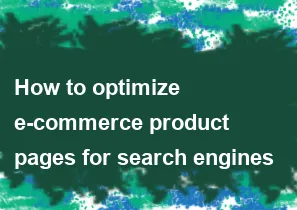How to optimize e-commerce product pages for search engines

Optimizing e-commerce product pages for search engines is crucial for improving visibility and attracting potential customers. Here are some effective strategies to optimize your product pages for search engines:
Keyword Research:
- Identify relevant keywords that potential customers might use to find your products.
- Utilize tools like Google Keyword Planner, SEMrush, or Ahrefs to discover high-volume and relevant keywords.
Optimize Product Titles:
- Include the primary keyword in the product title.
- Keep titles concise but descriptive, highlighting key features or benefits.
- Avoid keyword stuffing; titles should sound natural and be user-friendly.
Write Compelling Product Descriptions:
- Create unique and engaging product descriptions.
- Highlight the product's features, benefits, and unique selling points.
- Use bullet points and headers for easy readability.
- Incorporate relevant keywords naturally.
Optimize URL Structure:
- Ensure your product URLs are clean, short, and include the target keyword.
- Avoid unnecessary parameters or symbols in the URL.
Utilize High-Quality Images:
- Use high-resolution images that showcase the product from various angles.
- Optimize image file names and alt tags with relevant keywords.
- Compress images for faster page loading times.
Implement Schema Markup:
- Use schema markup to provide search engines with additional information about your products.
- Schema can enhance rich snippets and improve the visibility of your products in search results.
Enable Product Reviews:
- Encourage and showcase user-generated content, including reviews and ratings.
- Positive reviews can improve trust and credibility, influencing search engine rankings.
Mobile Optimization:
- Ensure your product pages are mobile-friendly, as many users shop from mobile devices.
- Google prioritizes mobile-friendly websites in search rankings.
Improve Page Load Speed:
- Optimize images, use browser caching, and leverage Content Delivery Networks (CDNs) to enhance page loading speed.
- Google considers page speed as a ranking factor.
Create a Logical Site Structure:
- Organize products into relevant categories and subcategories.
- Maintain a logical hierarchy to make navigation easy for users and search engines.
Internal Linking:
- Implement internal links to connect related products and pages.
- This helps distribute link equity and improves the overall SEO of your site.
Monitor and Analyze Performance:
- Use tools like Google Analytics and Google Search Console to monitor your site's performance.
- Track key metrics, identify issues, and make data-driven optimizations.
Remember that SEO is an ongoing process, and staying updated on industry trends and algorithm changes is crucial for long-term success. Regularly review and update your e-commerce product pages based on performance data and evolving search engine guidelines.
-
Popular Post
- How to optimize for Google's About This Result feature for local businesses
- How to implement multi-language support in an Express.js application
- How to handle and optimize for changes in mobile search behavior
- How to handle CORS in a Node.js application
- How to use Vue.js with a UI framework (e.g., Vuetify, Element UI)
- How to configure Laravel Telescope for monitoring and profiling API requests
- How to create a command-line tool using the Commander.js library in Node.js
- How to implement code splitting in a React.js application
- How to use the AWS SDK for Node.js to interact with various AWS services
- How to use the Node.js Stream API for efficient data processing
- How to implement a cookie parser middleware in Node.js
- How to implement WebSockets for real-time communication in React
-
Latest Post
- How to implement a dynamic form with dynamic field styling based on user input in Next.js
- How to create a custom hook for handling user interactions with the browser's device motion in Next.js
- How to create a custom hook for handling user interactions with the browser's battery status in Next.js
- How to implement a dynamic form with dynamic field visibility based on user input in Next.js
- How to implement a dynamic form with real-time collaboration features in Next.js
- How to create a custom hook for handling user interactions with the browser's media devices in Next.js
- How to use the useSWRInfinite hook for paginating data with a custom loading indicator in Next.js
- How to create a custom hook for handling user interactions with the browser's network status in Next.js
- How to create a custom hook for handling user interactions with the browser's location in Next.js
- How to implement a dynamic form with multi-language support in Next.js
- How to create a custom hook for handling user interactions with the browser's ambient light sensor in Next.js
- How to use the useHover hook for creating interactive image zoom effects in Next.js